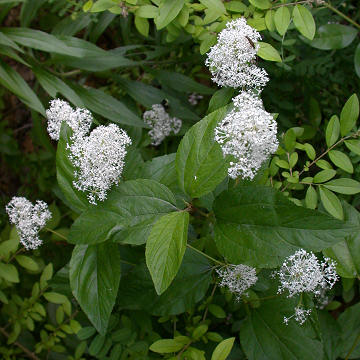

Ceanothus americanus - (image 1 of 3)
Taxonomy
Family: Rhamnaceae
Habitat
Black oak savannas, mesic and dry prairies, mixed deciduous forests.
Associates
In oak savanna found growing with Anemone cylidrica, Artemisia caudata, Asclepias tuberosa, Aster azureus, Euphorbia corollata, Helianthus divaricatus, Liatris aspera, Lithospermum croceum, Lupinus perennis, Phlox pilosa, Pteridium aquilinum, Rhus rydbergii, Rosa carolina, Solidago speciosa.
Distribution
Quebec west to MN, south to FL and TX.
Morphology
Woody, multi-stemmed shrub to 1 m. Leaves 3-veined, toothed, mostly ovate, the larger ones more than 2 cm wide. Flowers in short-cylindric to ovoid panicles borne on axilliary peduncles, the peduncles progressively longer towards the base of the plant, to 20 cm long; petals 5, white.
Notes
Flowers early June to early October.
Wetland indicator: Upland.
Reputed to fix atmospheric nitrogen and well adapted to fire. Also called redroot, this plant gets it's name from it's historical use as a tea replacement during the Revolutionary War.
References
Gleason, Henry A.
and A. Cronquist. 1991. Manual of Vascular Plants of Northeastern United States
and Adjacent Canada. Second Ed.
The New York Botanical Garden. Bronx, NY
Swink, F. and G.
Wilhelm. 1994. Plants of the Chicago Region.
Indiana Academy of Science. The Morton Arboretum. Lisle, Illinois.
USDA, NRCS. 2002. The PLANTS Database, Version 3.5 (http://plants.usda.gov).
National Plant Data Center, Baton Rouge, LA 70874-4490 USA.
|
Michael Hough © 2004 |